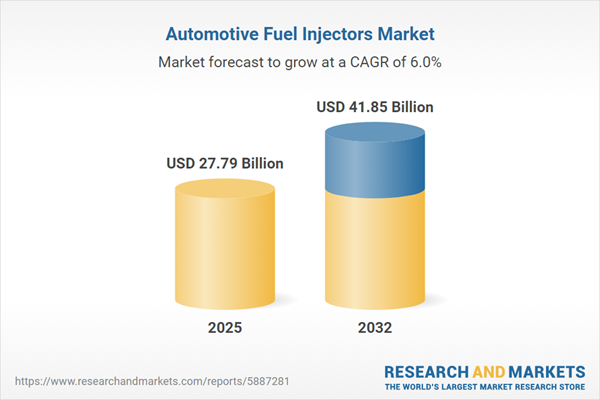Speak directly to the analyst to clarify any post sales queries you may have.
The automotive fuel injectors market is rapidly evolving as senior executives adapt to new technologies, shifting regulatory demands, and dynamic supply networks. Navigating these changes is essential for organizations aiming to achieve operational durability and regulatory alignment within a competitive global landscape.
Market Snapshot: Automotive Fuel Injectors Market Size & Outlook
The global automotive fuel injectors market is valued at USD 26.22 billion in 2024. Projections indicate growth to USD 27.79 billion in 2025 and USD 41.85 billion by 2032, with a compound annual growth rate of 6.01%. The sector is shaped by advancements in both piezoelectric and solenoid injector systems, which set new performance and compliance benchmarks. Manufacturers and suppliers are intensifying innovation to deliver adaptable, regulation-compliant fuel injectors, while automotive OEMs increasingly specify systems compatible with both combustion and hybrid platforms. The harmonization of cross-border standards is accelerating the adoption of scalable, future-ready injector technologies and expanding opportunities for market participants preparing for regulatory shifts.
Scope & Segmentation of the Automotive Fuel Injectors Market
This analysis supports senior leaders with actionable intelligence for strategic, procurement, and technology planning. The scope is structured to inform decisions on market entry, supplier relationships, and compliance management in evolving operational contexts:
- Application: Includes commercial fleets and passenger vehicles such as trucks, buses, SUVs, vans, and standard cars, helping stakeholders consider operational efficiency and lifespan across diverse vehicle segments.
- Engine Type: Focuses on diesel and gasoline configurations, analyzing both Gasoline Direct Injection and Multi-Point Injection, providing clarity on efficiency, performance, and emissions control for different engine architectures.
- Injector Type: Covers piezoelectric injectors for their dosing accuracy and solenoid injectors for their adaptability, relevant to a wide array of automotive platforms.
- Distribution Channel: Considers both original equipment manufacturer (OEM) and aftermarket supply channels, allowing analysis of maintenance standards, component longevity, and operational suitability across different phases of the vehicle lifecycle.
- Operation Pressure: Addresses the implications of high, medium, and low-pressure injector systems, connecting choices in injector pressure to targeted engine outcomes and ecological responsibility.
- Nozzle Type: Evaluates single-hole and multi-hole nozzle systems, with attention to their effect on atomization, combustion, and emissions.
- Regions: Encompasses North America, Latin America, Europe, Middle East & Africa, and Asia-Pacific, offering regional insights into adoption patterns, OEM strategies, and local regulatory landscapes.
- Key Players: Analyzes strategies and investments by leading companies such as Robert Bosch GmbH, DENSO Corporation, Continental AG, Hitachi Automotive Systems, Keihin Corporation, Valeo, and Delphi Technologies PLC, offering executive-level perspective on competitive dynamics.
Key Takeaways for Senior Decision-Makers
- OEM and supplier collaboration is vital for adapting to ongoing regulatory revisions and ensuring injector platforms remain flexible for next-generation vehicle architectures.
- Technological development supports seamless integration of injector systems across conventional and hybrid vehicles, helping leaders realize robust fleet management and futureproofing objectives.
- In-depth market segmentation enables more effective investment prioritization, rapid supplier assessment, and swift adaptation to emerging operational or regulatory challenges.
- The adoption of modular and digitally connected injector solutions fosters predictive maintenance, enhancing resiliency in aftermarket care and service models.
- Strategic supply chain diversification protects against regional disruptions, safeguarding business continuity as global regulations and trade patterns fluctuate.
United States 2025 Tariff Impact Analysis
Adjustments to U.S. automotive tariffs are prompting manufacturers to revise sourcing and assembly strategies and capitalize on global collaboration. Digital traceability and targeted investment in logistics infrastructure are driving efficiency improvements and enabling rapid, informed responses to changing trade restrictions and compliance requirements.
Methodology & Data Sources
Research results derive from extensive secondary analysis and in-depth interviews with automotive engineers, supply chain decision-makers, and industry consultants. The methodology incorporates value chain mapping and formal SWOT evaluation, ensuring findings are relevant and actionable for executive leadership.
Why This Report Matters
- Equips executive teams to anticipate evolving regulations, manage supplier selection, and specify technology requirements confidently within the automotive fuel injectors market.
- Supports critical procurement and manufacturing decisions while fostering robust partnerships and ensuring high-performing, compliant component supply.
- Facilitates proactive risk management and supplier evaluation as standards progress and competitive dynamics shift.
Conclusion
This report equips senior automotive executives to strengthen technology strategies, optimize supplier engagement, and maintain resilience as market demands and regulatory priorities shift.
Additional Product Information:
- Purchase of this report includes 1 year online access with quarterly updates.
- This report can be updated on request. Please contact our Customer Experience team using the Ask a Question widget on our website.
Table of Contents
3. Executive Summary
4. Market Overview
7. Cumulative Impact of Artificial Intelligence 2025
Companies Mentioned
The companies profiled in this Automotive Fuel Injectors market report include:- Robert Bosch GmbH
- DENSO Corporation
- Continental AG
- Hitachi Automotive Systems, Ltd.
- Keihin Corporation
- Valeo
- Delphi Technologies PLC
Table Information
| Report Attribute | Details |
|---|---|
| No. of Pages | 197 |
| Published | October 2025 |
| Forecast Period | 2025 - 2032 |
| Estimated Market Value ( USD | $ 27.79 Billion |
| Forecasted Market Value ( USD | $ 41.85 Billion |
| Compound Annual Growth Rate | 6.0% |
| Regions Covered | Global |
| No. of Companies Mentioned | 8 |









